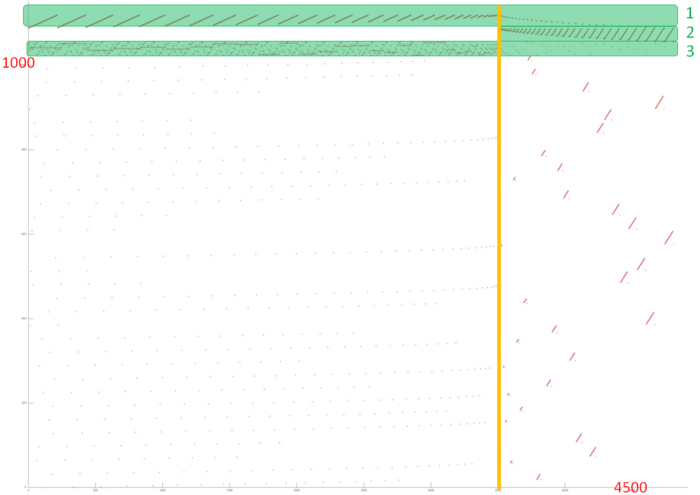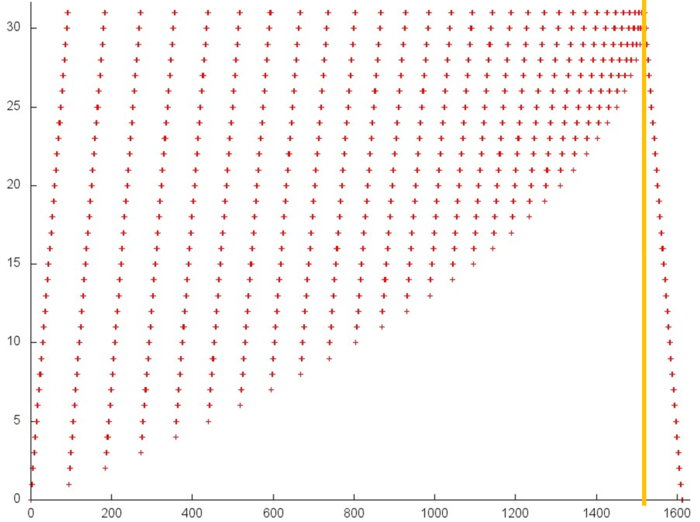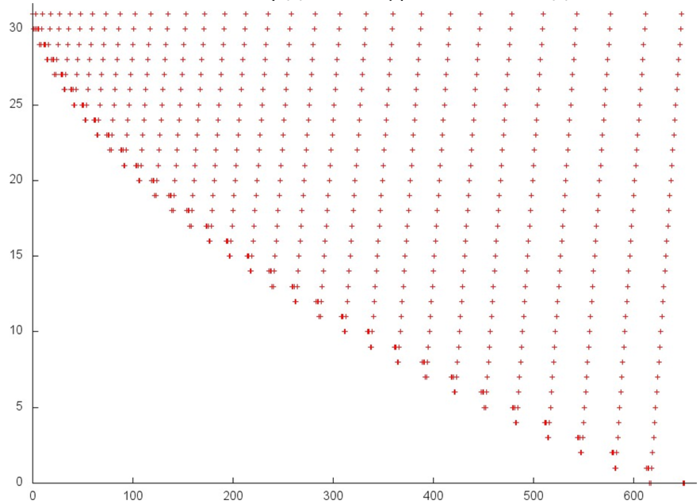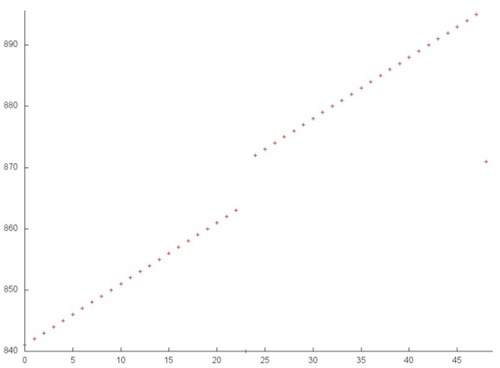Back substitution
Основные авторы описания: А.В.Фролов, Вад.В.Воеводин (раздел 2.2)
Contents
- 1 Properties and structure of the algorithm
- 1.1 General description
- 1.2 Mathematical description
- 1.3 Computational kernel of the algorithm
- 1.4 Macrostructure of the algorithm
- 1.5 The implementation scheme of the sequential algorithm
- 1.6 Sequential complexity of the algorithm
- 1.7 Information graph of the algorithm
- 1.8 Parallelization resources of the algorithm
- 1.9 Input and output data of the algorithm
- 1.10 Properties of the algorithm
- 1.11 Implementation peculiarities of the sequential algorithm
- 1.12 Locality of data and computations
- 1.13 Возможные способы и особенности реализации параллельного алгоритма
- 1.14 Масштабируемость алгоритма и его реализации
- 1.15 Динамические характеристики и эффективность реализации алгоритма
- 1.16 Выводы для классов архитектур
- 1.17 Существующие реализации алгоритма
- 2 References
1 Properties and structure of the algorithm
1.1 General description
Backward substitution is a procedure of solving a system of linear algebraic equations [math]Ux = y[/math], where [math]U[/math] is an upper triangular matrix whose diagonal elements are not equal to zero. The matrix [math]U[/math] can be a factor of another matrix [math]A[/math] in its decomposition (or factorization) [math]LU[/math], where [math]L[/math] is a lower triangular matrix. This decomposition can be obtained by many methods (for example, the Gaussian elimination method with or without pivoting, the Gaussian compact scheme, the Cholesky decomposition, etc.). Here we also should mention the [math]QR[/math] decomposition when the matrix [math]A[/math] is represented in the form [math]A=QR[/math], where [math]Q[/math] is an orthogonal matrix and [math]R[/math] is an upper triangular matrix. Since the matrix [math]U[/math] is triangular, a procedure of solving a linear system with the matrix [math]U[/math] is a modification of the general substitution method and can be written using simple formulas.
A similar procedure of solving a linear system with a lower triangular matrix is called the forward substitution (see [1]). Note that the backward substitution discussed here can be considered as a part of the backward Gaussian elimination in the Gaussian elimination method for solving linear systems.
There exists a similar method called the backward substitution with normalization. The scheme of this modification is more complex, since a number of special operations are performed to reduce the effect of round-off errors on the results. This modified method is not discussed here.
1.2 Mathematical description
Input data: an upper triangular matrix [math]U[/math] whose elements are denoted by [math]u_{ij}[/math]); a right-hand vector [math]y[/math] whose components are denoted by [math]y_{i}[/math]).
Output data: the solution vector [math]x[/math] whose components are denoted by [math]x_{i}[/math]).
The backward substitution algorithm can be represented as
- [math] \begin{align} x_{n} & = y_{n}/u_{nn} \\ x_{i} & = \left (y_{i} - \sum_{j = i+1}^{n} u_{ij} x_{j} \right ) / u_{ii}, \quad i \in [1, n - 1]. \end{align} [/math]
There exists a block version of this algorithm; however, here we consider only its “dot” version.
1.3 Computational kernel of the algorithm
The computational kernel of the backward substitution algorithm can be composed of [math]n-1[/math] dot products of subrows of the matrix [math]U[/math] with the computed part of the vector [math]x[/math]:
- [math] \sum_{j = i+1}^{n} u_{ij} x_{j} [/math].
Here the dot products can be accumulated in double precision for additional accuracy. These dot products are subtracted from the components of the vector [math]y[/math] and the results are divided by the diagonal elements of the matrix [math]U[/math]. In some implementations, however, this approach is not used. In these implementations, the operation
- [math] y_{i} - \sum_{j = i+1}^{n} u_{ij} x_{j} [/math]
is performed by subtracting the componentwise products as part of dot products from [math]y_{i}[/math] instead of subtracting the entire dot product from [math]y_{i}[/math]. Hence, the operation
- [math] y_{i} - \sum_{j = i+1}^{n} u_{ij} x_{j} [/math]
and the division of the results by the diagonal elements of the matrix should be considered as a computational kernel instead of the dot product operations. Here the accumulation in double precision can also be used.
1.4 Macrostructure of the algorithm
As is stated in description of algorithm’s kernel, the major part of the algorithm consists of computing the ([math]n-1[/math]) sums
- [math]y_{i} - \sum_{j = i+1}^{n} u_{ij} x_{j} [/math]
and dividing the results by the diagonal elements of the matrix. The accumulation in double precision can also be used.
1.5 The implementation scheme of the sequential algorithm
The first stage of this scheme can be represented as
1. [math]x_{n} = y_{n}/u_{nn}[/math].
At the second stage, for all [math]i[/math] form [math]n-1[/math] to [math]1[/math], the following operations should be performed:
2. [math]x_{i} = \left (y_{i} - \sum_{j = i+1}^{n} u_{ij} x_{j} \right ) / u_{ii}[/math].
Note that the computations of the sums [math]y_{i} - \sum_{j = i+1}^{n} u_{ij} x_{j}[/math] are performed in the accumulation mode by subtracting the products [math]u_{ij} x_{j}[/math] from [math]y_{i}[/math] for [math]j[/math] from [math]n[/math] to [math]i + 1[/math] with decreasing [math]j[/math]. Other orders of summation lead to a severe degradation of parallel properties of the algorithm. As an example, we can mention a program fragment given in [2], where the backward substitution is discussed in the form of the backward Gaussian elimination performed with increasing summation index because of the restrictions imposed by old versions of Fortran.
1.6 Sequential complexity of the algorithm
The following number of operations should be performed for the backward substitution in the case of solving a linear system with an upper triangular matrix of order [math]n[/math] using a sequential most fast algorithm:
- [math]n[/math] divisions
- [math]\frac{n^2-n}{2}[/math] additions (subtractions),
- [math]\frac{n^2-n}{2}[/math] multiplications.
The main amount of computational work consists of multiplications and .additions (subtractions)
In the accumulation mode, the multiplication and subtraction operations should be made in double precision (or by using the corresponding function, like the DPROD function in Fortran), which increases the overall computation time of the algorithm.
Thus, the computational complexity of the backward substitution algorithm is equal to [math]O(n^2)[/math].
1.7 Information graph of the algorithm
Let us describe the algorithm’s graph analytically and in the form of a figure.
Граф алгоритма обратной подстановки состоит из двух групп вершин, расположенных в целочисленных узлах двух областей разной размерности. The graph of the backward substitution algorithm]consists of two groups of vertices positioned in the integer-valued nodes of two domains of different dimension.
450px|thumb|left|Fig. 1. Backward substitution.
The first group of vertices belongs to the one-dimensional domain corresponding to the division operation. The only coordinate [math]i[/math] of each vertex changes in the range from [math]n[/math] to [math]1[/math] and takes all the integer values from this range.
The dividend of this division operation:
- for [math]i = n[/math]: the input data element [math]y_{n}[/math];
- for [math]i \lt n[/math]: the result of the operation corresponding to the vertex of the second group with coordinates [math]i[/math], [math]i+1[/math].
The divisor of this division operation is the input data element [math]u_{nn}[/math].
The result of this operation is the output data element [math]x_{i}[/math].
The second group of vertices belongs to the two-dimensional domain corresponding to the operation [math]a-bc[/math].
The coordinates of this domain are as follows:
- the coordinate [math]i[/math] changes in the range from [math]n-1[/math] to [math]1[/math] and takes all the integer values from this range;
- the coordinate [math]j[/math] changes in the range from [math]n[/math] to [math]i+1[/math] and takes all the integer values from this range.
The arguments of this operation:
- [math]a[/math]:
- for [math]j = n[/math]: the input data element [math]y_{i}[/math];
- for [math]j \lt n[/math]: the result of the operation corresponding to the vertex of the second group with coordinates [math]i, j+1[/math];
- [math]b[/math]: the input data element [math]u_{ij}[/math];
- [math]c[/math]: the result of the operation corresponding to the vertex of the first group with coordinate [math]j[/math];
The result of this operation is intermediate for the backward substitution algorithm.
The above graph is illustrated in Fig. 1 for [math]n = 5[/math]. In this figure, the vertices of the first group are highlighted in yellow and are marked by the division sign; the vertices of the second group are highlighted in green and are marked by the letter f. The graph shows the input data transfer from the vector [math]y[/math], whereas the transfer of the matrix elements [math]u_{ij}[/math] to the vertices is not shown.
1.8 Parallelization resources of the algorithm
In order to implement the backward substitution algorithm for a linear system with an upper triangular matrix of order [math]n[/math], a parallel version of this algorithm should perform the following layers of operations:
- [math]n[/math] layers of divisions (one division on each of the layers),
- [math]n - 1[/math] layers of multiplications and [math]n - 1[/math] layers of addition/subtraction (on each of the layers, the number of these operations is linear and varies from [math]1[/math] to [math]n-1[/math].
Contrary to a sequential version, in a parallel version the division operations require a significant part of overall computational time. The existence of isolated divisions on some layers of the parallel form may cause other difficulties for particular parallel computing architectures. In the case of programmable logic devices (PLD), for example, the operations of multiplication and addition/subtraction can be conveyorized, which is efficient in resource saving for programmable boards, whereas the isolated division operations acquire resources of such boards and force them to be out of action for a significant period of time.
In addition, we should mention the fact that the accumulation mode requires multiplications and subtraction in double precision. In a parallel version, this means that almost all intermediate computations should be performed with data given in their double precision format. Contrary to a sequential version, hence, the amount of the necessary memory increases to some extent.
Thus, the backward substitution algorithm belongs to the class of algorithms of linear complexity in the sense of the height of its parallel form; its complexity is also linear in the sense of the width of its parallel form.
1.9 Input and output data of the algorithm
Input data: an upper triangular matrix [math]U[/math] of order [math]n[/math] whose elements are denoted by [math]u_{ij}[/math] and the right-hand side vector [math]y[/math] whose components are denoted by [math]y_{i}[/math]).
Amount of input data: :[math]\frac{n (n + 3)}{2}[/math]; since the matrix is triangular, it is sufficient to store only the nonzero elements of the matrix [math]U[/math]).
Output data: the solution vector [math]x[/math] whose components are denoted by [math]x_{i}[/math]).
Amount of output data: [math]n[/math].
1.10 Properties of the algorithm
In the case of unlimited computer resources, the ratio of the sequential complexity to the parallel complexity is linear (the ratio of quadratic complexity to linear complexity).
The computational power of the Cholesky algorithm considered as the ratio of the number of operations to the amount of input and output data is only a constant.
The backward substitution algorithm is completely deterministic. Another order of associative operations is not considered for this algorithm’s version under study, since in this case the structure of the algorithm radically changes and the parallel complexity becomes quadratic.
The linear number of the parallel form layers consisting of a single division slows the performance of the parallel version and is a bottleneck of the algorithm, especially compared to the forward substitution, where the diagonal elements are equal to 1. In this connection, when solving linear systems, it is preferable to use the triangular decompositions for which the triangular factors contain the diagonals whose elements are equal to 1. When such triangular factors are nonsingular, it is useful, before solving the linear system, to transform them the product of a diagonal matrix and a triangular matrix whose diagonal elements are equal to 1.
There exist several block versions of the backward substitution algorithm. The graphs of some of them are almost coincident with the graph of the dot version; the distinctions consist in the ways of unrolling the loops and their rearrangements. Such an approach is useful to optimize the data exchange for particular parallel computing systems.
Software implementation ==
1.11 Implementation peculiarities of the sequential algorithm
In its simplest version, the backward substitution algorithm can be represented in Fortran as
X(N) = Y(N) / U (N, N)
DO I = N-1, 1, -1
S = Y(I)
DO J = N, I+1, -1
S = S - DPROD(U(I,J), X(J))
END DO
X(I) = S / U(I,I)
END DO
Here [math]S[/math] is a double precision variable if the accumulation mode is used.
1.12 Locality of data and computations
1.12.1 Locality of implementation
1.12.1.1 Structure of memory access and a qualitative estimation of locality
Figure 2 illustrates a general memory-access profile for an implementation chosen to study the backward Gaussian elimination. From this figure it follows that this profile consists of two stages (the boundary between them is highlighted in orange). These stages correspond to the two loops of this implementation taken for our analysis. Based on this analysis, we conclude that the memory-access profile consists of the references to 4 arrays. In Fig. 2, three of them are highlighted in green; the other references are made to the fourth array. Note that the total number of references is greater only by several times than the number of the used elements (4500 and 1000, respectively). Hence, it is difficult to achieve a high degree of locality.
In order to clarify this situation, we consider each of these arrays individually.
Figure 3 illustrates fragment 1. The orange line delimits the above two stages. The second stage is a linear search in the reverse order. The first stage is iterative: at each iteration, the array’s element with the smallest number is dropped. Such a profile is characterized by a high spatial locality, since the elements are searched in succession, and by a sufficiently high temporal locality, since the repeated references are made to the same elements at each iteration.
Figure 4 illustrates fragment 2 corresponding to the references to the second array. This fragment is smaller than the previous one: only 600 memory references. In essence, this fragment is similar to stage 1 of fragment 1, the only distinction consists in the fact that the iterations are performed in the reverse order. However, this distinction gas a little effect on the spatial locality and on the temporal locality. Hence, fragment 2 possesses the same properties.
Figure 5 illustrates fragment 3. The orange line also delimits the above two stages. A small number of references are made at the second stage. The references of the first stage are similar to a random access occurring frequently in the case of indirect addressing. Sometimes, many references are made to a certain element in succession, but after that this element is no more used. Usually, such a profile is characterized by a low spatial and temporal locality; however, this disadvantage is not so important, since the number of the element in use is small.
Now we consider the fragment occupying the major part of Fig. 2. This profile is presented in Fig. 5. The following peculiarity of this profile should be mentioned: more than 1000 elements are used, whereas about 30 elements are used in the other profiles. The number of references is less than the number of references to the first and third arrays.
It should also be noted that the major part of references are made at the second stage. The first stage is similar to the first stage of the previous array (Fig. 5); the only exception consists in the fact that in this profile there no multiple references in succession to a single element before this element is no more used. The first stage consists of about 500 references distributed uniformly on a segment of 1000 elements; hence, a very low spatial and temporal locality is observed.
At the second stage, the references are of another character. This stage possesses a higher spatial locality, since the references are grouped in clusters whose structures are similar. However, the structure of the cluster itself requires a deeper analysis.
Figure 7 illustrates the two clusters highlighted in green in Fig. 6. The scale of Fig. 7 allows one to see that each cluster is a linear search with a small step in a subset of the array elements.
Hence, we can conclude that the second stage of fragment 4 possesses a sufficiently high spatial locality, since each cluster contains linear search operations, but the temporal locality is low, since the repeated references are almost absent.
The following conclusion can be made for the entire profile: the first three arrays (especially, the first and second arrays) have a sufficiently high locality. However, a rather low spatial locality and a very low temporal locality of the fourth array significantly reduce the general locality of the entire implementation under study.
1.12.1.2 Количественная оценка локальности
Основной фрагмент реализации, на основе которого были получены количественные оценки, приведен здесь (функция Kernel2). Условия запуска описаны здесь.
Первая оценка выполняется на основе характеристики daps, которая оценивает число выполненных обращений (чтений и записей) в память в секунду. Данная характеристика является аналогом оценки flops применительно к работе с памятью и является в большей степени оценкой производительности взаимодействия с памятью, чем оценкой локальности. Однако она служит хорошим источником информации, в том числе для сравнения с результатами по следующей характеристике cvg.
На рисунке 12.7 приведены значения daps для реализаций распространенных алгоритмов, отсортированные по возрастанию (чем больше daps, тем в общем случае выше производительность). Можно увидеть, что, в соответствии с высказанным в предыдущем разделе предположением о негативном влиянии одного из массивов, данная программа показывает достаточно низкую производительность, заметно ниже, чем у прямого хода метода Гаусса.
Вторая характеристика – cvg – предназначена для получения более машинно-независимой оценки локальности. Она определяет, насколько часто в программе необходимо подтягивать данные в кэш-память. Соответственно, чем меньше значение cvg, тем реже это нужно делать, тем лучше локальность.
На рисунке 12.8 приведены значения cvg для того же набора реализаций, отсортированные по убыванию (чем меньше cvg, тем в общем случае выше локальность). Можно увидеть, что, согласно данной оценке, профиль обращений обладает низкой локальностью, лишь немногим лучше профиля программы со случайным доступом в память. Это повторяет выводы, сделанные на основе оценки daps.
1.13 Возможные способы и особенности реализации параллельного алгоритма
Вариантов параллельной реализации алгоритма не так уж и много, если не использовать то, что оба главных цикла можно развернуть, перейдя, таким образом, к блочной версии. Версии без развёртывания циклов возможны как с полностью параллельными циклами по I:
DO PARALLEL I = 1, N
X(I) = Y(I)
END DO
DO J = N, 1, -1
X(J) = X(J) / U(J,J)
DO PARALLEL I = 1, J-1
X(I) = X(I) - U(I,J)*X(J)
END DO
END DO
так и с использованием "скошенного параллелизма" в главном гнезде циклов.
1.14 Масштабируемость алгоритма и его реализации
1.14.1 Описание масштабируемости алгоритма
1.14.2 Описание масштабируемости реализации алгоритма
1.15 Динамические характеристики и эффективность реализации алгоритма
1.16 Выводы для классов архитектур
Если исходить из структуры алгоритма, то при реализации на суперкомпьютерах следует выполнить две вещи. Во-первых, для минимизации обменов между узлами следует избрать блочный вариант, в котором или все элементы матрицы доступны на всех узлах, или заранее распределены по узлам. В таком случае количество передаваемых между узлами данных будет невелико по сравнению с количеством арифметических операций. Но при такой организации работы получится, что наибольшие временные затраты будут связаны с неоптимальностью обработки отдельных блоков. Поэтому, видимо, следует сначала оптимизировать не блочный алгоритм в целом, а подпрограммы, используемые на отдельных процессорах: точечный метод обратной подстановки, перемножения матриц и др. подпрограммы. Ниже содержится информация о возможном направлении такой оптимизации.
1.17 Существующие реализации алгоритма
Вещественный вариант обратной подстановки реализован как в основных библиотеках программ отечественных организаций, так и в западных пакетах LINPACK, LAPACK, SCALAPACK и др. При этом в отечественных реализациях, как правило, выполнены стандартные требования к методу с точки зрения ошибок округления, то есть, реализован режим накопления, и обычно нет лишних операций. Реализация точечного метода Холецкого в современных западных пакетах обычно происходит из одной и той же реализации метода в LINPACK, а та использует пакет BLAS.
Для большинства пакетов существует блочный вариант обратной подстановки, в том числе и тот, граф которого топологически тождествен графу точечного варианта. Из-за того, что количество читаемых данных примерно равно количеству операций, блочность может дать некоторое ускорение работы благодаря лучшему использованию кэшей процессоров. Именно в направлении оптимизации кэширования и следует сосредоточить основные усилия при оптимизации работы программы.
2 References
- V.V. Voevodin, Yu.A. Kuznetsov. Matrices and computations. Moscow: Nauka, 1984 (in Russian).
- G. Forsythe and C. Moler. Computer Solution of Linear Algebraic Systems. Englewood Cliffs: Prentice Hall, 1967 (Russian translation: Дж.Форсайт, К.Моллер. Численное решение систем линейных алгебраических уравнений.М.: Мир, 1969).






